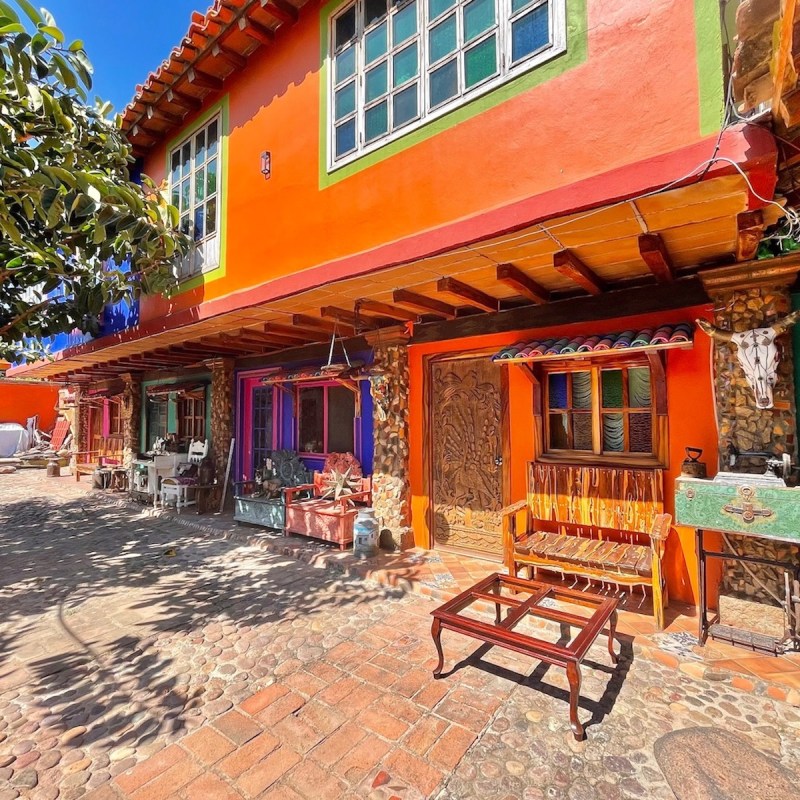
El Quelite is often referred to as a magic town, though it is not yet large enough to obtain the official designation of Pueblo Magico (Magical Town) given by the Mexican government. Nevertheless, this colorful village casts a spell on many visitors. Only 25 miles from Mazatlan, El Quelite is one of the most popular day trips in the state of Sinaloa.
Videos by TravelAwaits
Here, cobblestone streets are more likely to echo the clop-clop of horses’ hooves than the rumble of automobiles. Tropical colors of azure, ochre, and coral adorn every house and building. Hibiscus and bougainvillea create a riot of color. Cacti grow from terracotta rooftops.
Note: My trip to El Quelite was part of a sponsored trip to Mazatlan. All opinions are my own.
How To Get There
You can rent a car and drive yourself, or hire a guide to take you there. If it’s your first time, I recommend the latter. For example, a recent storm damaged the bridge on the usual road to El Quelite. The group I was traveling with took an alternate road that cut through a low jungle; there were no landmarks, only signs on the side of the road. A local guide will know which route is best and ensure you arrive safely.
You’ll know you’ve arrived when you see a red stucco arch that crosses the road announcing that you are welcome in El Quelite! On your right is the river, which supplies water as well as lending the town its name.

Discover The History And Culture Of El Quelite
Just beyond the welcome arch is a sculpture of a man balancing a ball on his hip. In real life, the ball is made of solid rubber and weighs about 7 pounds. The game is called Ulama and was played as early as 1000 B.C. Though it was popular throughout Mesoamerica, today it is only played in a few villages around the state of Sinaloa. It is possible to see a demonstration when visiting El Quelite. Book in advance or through a tour service.
Once you’re on the main road in town, the best way to discover El Quelite is on foot. Almost everything is on the main street, but there are a few interesting side streets to discover. We also saw people riding horses around town.
El Quelite is anchored by the 19th-century Cathedral of Our Lady of Guadalupe. The plaza surrounding the church is shady, and there are pretty benches inviting you to relax and enjoy the serenity of rural life under large, flowering trees. Behind the church is a covered pavilion where village social life unfolds, as kids play games and adults simply engage in conversation. The cathedral has an active congregation and is open to the public.

Along the main street, browse the colorful shops and galleries selling clothing, art, shoes, and local candies and pastries. The prices are reasonable, and there is no pressure to buy anything. One shop sells handmade leather sandals called huaraches, as well as small dry goods. It is sort of like a mini-mart that sells shoes. Street vendors display delicious local foods, especially sweets like dried mango and papaya. A fresh and very mild cheese is also made in the area, and you’ll likely be offered samples to try.
El Quelite is primarily a town that survives on agriculture, but one man, Dr. Marco Osuna, is changing that. Born and raised in this area, Dr. Osuna is a big supporter of tourism. In fact, he is probably the one person most responsible for putting El Quelite on the path to obtaining Mexico’s Pueblo Magico designation.

El Meson De Los Laureanos
El Meson De Los Laureanos, a local restaurant, is the perfect place to learn about El Quelite and the many initiatives of Dr. Osuna to create a sustainable economy and provide jobs for locals. The restaurant was his family home and contains many artifacts, photographs, and colorful murals depicting the history of Sinaloa.

El Meson De Los Laureanos exemplifies farm-to-table. Everyone working at the restaurant lives nearby. On your drive into town, you will pass many farms which raise the animals and grow the vegetables that are served in the restaurant. I think it is safe to say that this is the prototype for a local dining experience where the farmers, chef, and restaurant owner are all involved in the production. And just to make sure you know where you are, roosters wander freely, and will occupy a chair if you let them! Rooster farms are plentiful around El Quelite because cockfighting is still a popular pastime in Mexico. While I don’t support it, it is part of the culture.

As soon as our group was seated, pitchers of hibiscus tea and horchata were passed around the table, along with Pacifico, the local beer, and margaritas. Then the food began to arrive… carnitas, beef tongue, quail, pork knuckles, shredded barbeque beef, handmade corn tortillas, along with a plate of garnishes of chopped onion, jalapenos, and limes. The food was delicious, plentiful, and fresh. Dessert was also a smorgasbord of choices unique to the restaurant and made with locally produced foods. We tasted dried mango, something like a rice pudding ( I loved it), and a sweet empanada. We all agreed that it was one of the most flavorful and authentic Mexican meals we had ever had.
Fun Fact: Los Laureanos is named for banditos who robbed the wagons carrying gold and silver from the nearby Sierra Madres to Mazatlan during the Mexican Revolution.
When city life and the stress of traveling become too much, retreating to the countryside and a rural town like El Quelite is the perfect antidote. The town is tiny and can be seen in half a day or, if you prefer a more leisurely pace, you could spend a full day there. The people are friendly and take pride in their town. If you take only one day trip from Mazatlan, let it be El Quelite.
Check out these other notable Mexico day trips:
